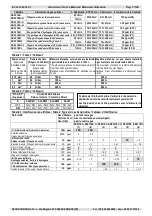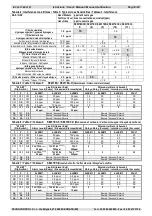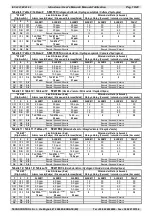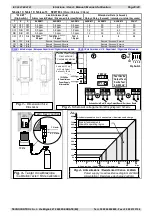
IST-2237.EC01.01
Istruzione / User’s Manual / Manuel d’utilisation
Pag. 11/20
TECNOCONTROL S.r.l. - Via Miglioli, 47 20090 SEGRATE (MI)
Tel. +39 02 26922890 - Fax +39 02 2133734
TEST and CALIBRATION
PAY ATTENTION
:
This procedure has to be made with extreme attention and by authorized and trained
people; because starting this procedure it will start both Outputs (relays) causing the activation of con-
nected alarm devices.
Operation Check, Zero Adjust, and Calibration
:
are different code protected functions. To access these func-
tions is necessary to insert the relevant “
Code
" through the keys F1s and F2. To have the key pressure recog-
nized, hold pressing it for around a second (
until the green Led doesn't switch off for a moment
). Then the next key can be
pressed. In case of error all it takes is waiting around 10 seconds and the sequence is automatically erased.
The
Calibration Check
is a function code free.
Calibration Kit, Sample Gas Bottles
(
for Calibration Check and Calibration
) the mixture to be used depending on the
model installed is shown in the table below:
MODEL
Sample gas bottle
Our Code / Valve
KIT Code
SE237EA - SE237EA-H
100 ppm
Ammonia (NH
3
)
in Nitrogen
BO501
/ BO303
TC014
SE237EC-S - SE237EC-H
300 ppm
Carbon monoxide (CO)
in Nitrogen
BO210
/ included
TC011
/TC014
SE237ES
10 ppm
Sulphur dioxide (SO
2
)
in Nitrogen
BO518
/ BO303
TC014
SE237EH
50 ppm
Hydrogen sulphide (H
2
S) in Nitrogen
BO520
/ BO303
TC014
SE237EHCN
10 ppm
Hydrogen cyanide (HCN) in Nitrogen
BO529
/ BO303
TC014
SE237EN
100 ppm
Nitric oxide (NO)
in Nitrogen
BO522
/ BO303
TC014
SE237EN2
30ppm
Nitrogen dioxide (NO
2
)
in air
Available on request
TC014
SE237EHCL
10ppm
Hydrogen cloride (HCL)
in Nitrogen
BO527
/ BO305
TC014
SE237ECL
10ppm
Nitrogen dioxide (NO
2
)
in air
Available on request
TC014
It is possible to use either the
disposable cylinders with adjust valve
or the high pressure ones with reduction
gear. Some cylinders have a fixed flow reducers, make the necessary value in
Table, column 3, page 11
. Is also nec-
essary the
Tecnocontrol calibration kit model TC014 (stainless steel)
. To ensure that the gas concentration
reaches sensor, use steel reduction gear and Teflon tubes or other compatible materials which do not disperse
gas.
“INSTRUMENT OPERATION CHECK” (
Check Code
: F2, F2, F1, F1)
:
this function allows to effect a functional test
of the detector. After having inserted the "
Check C
ode
", all Led are switched off and all the relays are deactivated.
Then they will switch on in sequence, the Led, from the yellow up to the 3° red. To the lighting of the various Led it
corresponds the activation of the relevant relays (
relay "FAULT" with the yellow Led, relay "ALARM1" with the 1° red Led, relay
"ALARM2" with the 2° red Led, relay "ALARM3" with the 3° red Led
). At the end all the Led will remain lighted for around 5
seconds, then the detector returns at the conditions of normal operation. It is advisable to perform this operation
every 12 months according to the use.
Note
: this function is not working if the 1° and/or the 2° and/or the 3° red
Led have already turned on.
“ZERO ADJUST” (
Zero Code
: F2, F1, F1, F2)
:
this function is to adjust the Zero sensor and can be done in clean
air only (
environment without the presence of toxic gas or other pollutants
). Consider that the SE237E series have a sophisti-
cated follower of zero, that every hour will reset the sensor, if of course there is the presence of gas. If necessary,
perform this operation after installation or after changing the “
Cartridge
” or every 6-12 months depending on envi-
ronmental conditions. After entering the "
Zero Code
" as confirmation of the operation, there will be a flashing 1
st
red
Led and output becomes 4.0 mA.
Note
: This function is not working if the 2
nd
and/or 3th red Led are already ON or the mA output is higher than the
value shown in the table below, depending on the model. In this case, please recalibrate the unit and/or replacing the
“
Cartridge
”. In case the 1
st
red Led will be already ON, only instead of flashing it will switch off for confirmation.
SE237EA
SE237EA-H
SE237EC-S
SE237EC-H
SE237ES
SE237EH
SE237EHCN
SE237EN
SE237EN2
SE237EHCL
SE237ECL
4,8 mA
15ppm NH
3
4,8 mA
15ppm CO
6,4 mA
3ppm SO
2
4,8 mA
5ppm H
2
S
8 mA
2,5ppm HCN
5,6 mA
10ppm NO
6,6 mA
5ppm NO
2
8 mA
2,5ppm HCL
4,8 mA
0,5ppm HCL
“CALIBRATION” (
Calibration Code
: F2, F2, F2, F1, F2, F1)
:
this function allows completely recalibrate the sensor
using the gas mixture indicated above.
Warning
:
to guarantee that no errors of elaboration happen, the possibility exists that during the Calibration the yel-
low Led switch off every 8 seconds, in this case interrupt the procedure, switch off and switch on the instrument and
repeat the Calibration. If condition persists it will be necessary to send the detector to the supplier for the reparation.
Important note:
during Calibration routine the mA output indicates 0mA
.
The “
Calibration
” can be done in clean air only (
environment without the presence of toxic or other polluting gas
). With the
keys perform the “
Calibration Code
". Wait until the yellow and green Led switch on fix and the 1
st
red Led starts to
flash. Insert the TC014 on the sensor holder and adjust the influx of the gas the way that the flow meter reaches
the value indicates in table below in
column 3
, depending on the model (
see also Fig.3
).
Wait around 3-5 minutes
, until the 3
rd
red Led lights (
and while it is ON
), press the key F2 and hold it pressed until
the 1
st
and 3
rd
red Led are switched off for at least 2 seconds (
but if the 1
st
red Led continues to blink more than 5-6
minutes means that the gas flow is not constant or unsatisfactory, or the concentration is not as required, stop the
operation, turn off the instrument and recalibrate
).
Then, close the gas cylinder and remove TC014
. At this point we
can have two possibilities:
Yellow and green Led illuminates:
the calibration routine is correct.
Wait 8 seconds, until the instrument auto-
matically restores the normal working conditions
.
(
See “
Operational Description > Preheating
”
).





































